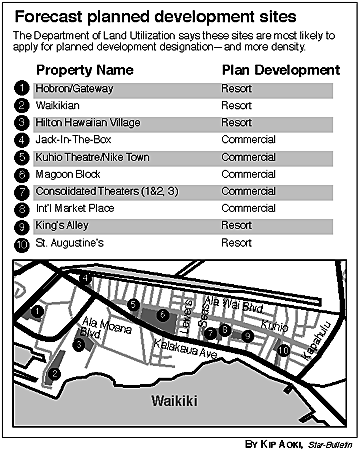
It hasn't even had its first hearing before the City Council but Mayor Jeremy Harris' plan to jumpstart development in Waikiki already has people taking sides.
For 20 years, the city's Waikiki Special District ordinance lived "to slow down the growth that had been rampant prior to 1976 - and it did do that," said Patrick Onishi, director of the city Department of Land Utilization. "We're coming back (now) and trying to see where have the impediments been and try to massage it a little bit to see what we can do to kickstart activity."
Not only are Waikiki hotels aging, the demand for first-class and luxury rooms far exceeds supply. Asian visitors prefer upper-end units, and the thousands expected to invade Waikiki when the convention center opens in 1998 will want the same, they say.
Slow-growth advocates, however, say the initiatives would throw out 20 years of carefully crafted land use policies. They fear the incentives could trigger a mini building boom that will backfire, leaving Waikiki more overcrowded, gridlocked and unattractive than ever before.
For Harris, the stakes are also high: He has made his "vision of Waikiki" a top priority in an election year.
The initiatives range from allowing sidewalk lei vendors, to major alterations in traffic patterns.
But two proposals generating the most debate would also cause the most significant changes:
Other negotiable points would include height (up to 350 feet), setbacks and open space. "Development advantages, where applicable, are considered in exchange for design and community benefits," said a DLU staff report.
Onishi's staff has identified 10 properties deemed "susceptible to change" that would be eligible for a Planned Development application. They include the Hobron-Gateway site owned by Outrigger, the St. Augustine's Church site, the International Market Place and the Magoon block.
Waikiki Councilman Duke Bainum said he endorses much of the mayor's Waikiki amendments. But constituents are worried about the potential for increased density, he said.
"A Planned Development is nothing more than another word for superblock," Bainum said. "And how does that relate to creating more open space and a Hawaiian sense of place?"
"There's no money to implement them," she said. "It's fuzzy thinking and I don't think that's careful planning."
"Traffic is gridlocked coming in and out of Waikiki already," said state Rep. Mary-Jane McMurdo (D-Waikiki/Ala Wai). "My feeling is if they're not very careful, they're going to kill the goose that laid the golden egg."
"It's reverting back to the '60s," said Donald Bremner, a planner and key figure in the 1976 Waikiki plan. The underlying reasons for the Waikiki Special District have not changed in the past two decades, he said. "We haven't got any more land to make Waikiki bigger and there has been nothing in new technology to relieve the impacts of overcrowding."
"Not all of our landowners feel that the economic incentive of that 20 percent increase in density would be able to pencil out to allowing them make major renovations," said David Dodge, executive director of the Waikiki Improvement Association.
Public meeting set for April 16
Mayor Jeremy Harris' proposed amendments to the Waikiki Special District will be aired 7 to 9:30 p.m. April 16 at the Sheraton Waikiki's Kauai Room. The meeting is sponsored by the city Office of Waikiki Development. The plan got a favorable recommendation from the city Planning Commission and now goes to the City Council.
"For some of them - and it really depends on a case-by-case basis - even 50 percent to 100 percent might not be enough incentive to rip out the property and build over," Dodge said.
Hotel owners and business interests also frown on other aspects of the Planned Development scheme, such as a Dec. 31, 2001, deadline to obtain building permits. They say developers should be given more time.
Debate has also begun on the nonconformity issue. The provision could have huge impacts because more than half of Waikiki buildings were grandfathered in with nonconforming density.
"With the value of an existing nonconforming building in Waikiki being so much greater than what is permitted under today's WSD, significant disincentives are institutionalized by the current zoning," states a DLU staff report.
"This is a serious problem when we consider the kinds of improvements needed to renovate and maintain the majority of Waikiki's properties. The current situation is a recipe for decline."
As with the Planned Development option, the city hopes to get open-space concessions for allowing existing excessive densities to stand after redevelopment.
That has raised some hackles. Dan Davidson of the Land Use Research Foundation, for instance, told the city Planning Commission that many property owners would be hard-pressed to rebuild with nonconforming room area when required to give 50 percent open space.
Bremner, meanwhile, said allowing nonconformities to be grandfathered in makes a mockery of the Waikiki Special District plan.
By legitimizing existing excesses, the city would actually increase the legal densities.
Waikiki Neighborhood Board member Rodger Snow agreed. "If the administration's plan is to allow nonconforming structures to be demolished and rebuilt with their nonconformity, then something is dreadfully wrong."
